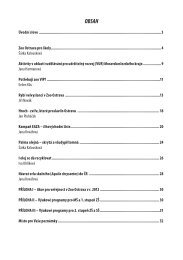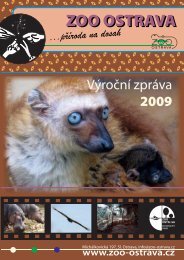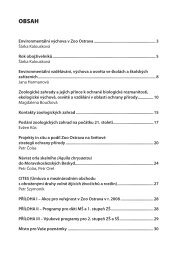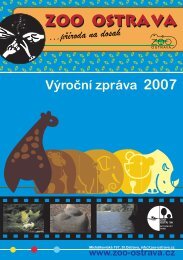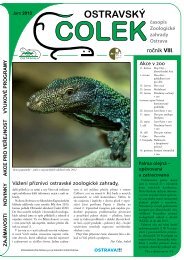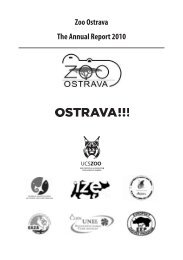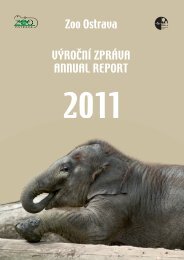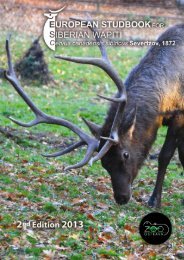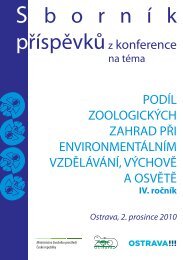You also want an ePaper? Increase the reach of your titles
YUMPU automatically turns print PDFs into web optimized ePapers that Google loves.
50<br />
Rehabilitation of the cinereous vulture and bearded vulture<br />
Jiří Novák<br />
Restoring parts of Mother Nature damaged by humanity is many times associated with satisfaction over the<br />
well done job and related gratification. In addition, seeing the wildlife returning to places of original range<br />
brings along intense excitement to people working in zoos. Even though the professional as well as laymen<br />
community is very well aware of the fact that <strong>Ostrava</strong> <strong>Zoo</strong> has long been involved in projects returning specific<br />
animal species into the wild in the Czech Republic or also Slovakia, <strong>2009</strong> became a real historical milestone,<br />
as not only two large and rare members of birds of prey were bred and reared for the first time at <strong>Ostrava</strong> <strong>Zoo</strong>,<br />
but even helped repopulate the native range of both species - the cinereous vulture and the bearded vulture<br />
- placed outside the Czech border, in French mountains.<br />
Both species are especially spectacular birds and their biology makes them highly attractive. <strong>The</strong>y do<br />
not compete with humans in terms of food or anything else, being neither hunters nor source of threat to<br />
domestic animals - indeed, eliminating carcasses of death vertebrates by eating is something through which<br />
these birds deliver an invaluable service to nature and in fact to man. <strong>The</strong> less we understand today why these<br />
birds were hunted by humans, driven to extinction in most places in Europe over time.<br />
<strong>The</strong> bearded vulture (Gypaetus barbatus) inhabits patchy areas in mountain and alpine ranges of Africa,<br />
Central Asia and Southern Europe and has now returned to the Alps, which is the region where this majestic<br />
bird of prey was exterminated by man - the last shot dates back to 1913. In 1978, an international project<br />
named Returning the bearded vulture into the Alps was launched, with stakeholders being not only zoological<br />
parks throughout Europe including <strong>Ostrava</strong>, but also boards of national parks in the Alps, World Wildlife Fund<br />
(WWF) and specialist breeding centres. First birds were released into the wild within the Austrian territory<br />
after 8 years of preparation in 1986; however, it took as much as 11 years before any first successful fledging<br />
could take place, which very well reflects how much time and struggling it takes to recover the previous<br />
actions of man. Nowadays, there are about 120 to 130 birds ranging freely in the Alps. <strong>The</strong> bearded vulture<br />
now already nests regularly in the territory of Austria, Switzerland, France and Italy, with as many as 40 young<br />
birds successfully fledged to date.<br />
<strong>The</strong> cinereous vulture (Aegypius monachus) resides in Asian mountain ranges up to the level of 4,000 m,<br />
while in Europe this bird have survived only in the mountains of the Pyrenean Peninsula, with rare vagrant<br />
birds seen in Central Europe. As with a number of other birds of prey, the cinereous vulture population has<br />
suffered a drastic decline in the wild, being now listed as Near Threatened in the IUCN's Red List of Threatened<br />
Species. A successfully running project of returning these imperial birds of prey into the specific localities of<br />
Europe, particularly those in France and in the Island of Mallorca, exists also for the cinereous vulture, with<br />
the zoo in <strong>Ostrava</strong> contributing their offspring produced in <strong>2009</strong>. <strong>The</strong> Mallorca population consisted of last<br />
remaining 20 vultures back in 1980, which thanks to the recruitment by captive-bred individuals increased<br />
to current 70 birds. In France, where the cinereous vulture was extirpated, the reintroduction scheme was<br />
launched in 1992, with subsequent first nesting of the birds released taking place in 1997.<br />
Rearing a young vulture or bearded vulture is nothing easy, which is supported by the fact that in <strong>2009</strong>, only<br />
two cinereous vulture chicks were successfully reared in Europe. Pitfalls do exist, and include the following:



